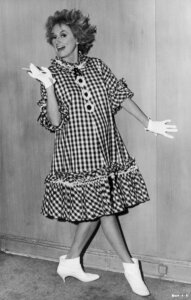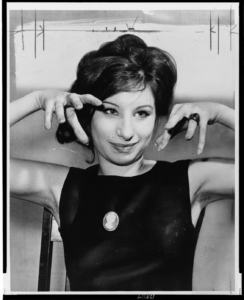How a star named Barbra Streisand was born at a club in Greenwich Village
‘Live at the Bon Soir’ was Streisand’s Beatles in Hamburg moment

Barbra Streisand making her Broadway debut at 19 in the musical “I Can Get It for You Wholesale” in 1962. Photo by Getty Images
On the evening of Nov. 5, 1962, the Beatles performed for 3 1/2 hours onstage at the Star-Club in Hamburg, Germany. It was the fifth show of a 14-night stint, their second residency at the massive venue in the Reeperbahn district, and one of 75 shows overall they’d perform there that grueling year.
“Love Me Do,” the band’s official debut single, had been out in the U.K. for a month and was currently chugging its way to its eventual chart peak of No. 17; in three weeks, the band would go into Abbey Road Studios to record “Please Please Me,” the single that would turn them into stars in Great Britain. At that moment, however, the Beatles were just another hardworking beat group; though they had the talent and charisma necessary to rock a 2,000-seater like the Star-Club, they still remained largely unknown outside of their rock ‘n’ roll bubble.
A career-changing gig
Several hours later, on the other side of the Atlantic, Barbra Streisand took the stage at the Bon Soir, a small club in New York City’s Greenwich Village. Though already acclaimed (and Tony-nominated) for her Broadway debut as Miss Marmelstein in the musical “I Can Get It for You Wholesale” — and already with a handful of “Tonight Show” appearances to her credit — Streisand had yet to become a household name. The higher-ups at Columbia Records, the label she’d signed with just a month earlier, hoped that this evening would change all that.
Though less than a tenth of the size of the Star-Club, the Bon Soir looms as large in Streisand’s legend as the Star-Club does in the Fab Four’s. She landed her first professional gig there in September 1960, opening for the comedian Phyllis Diller; originally hired for two weeks at $125 per, Streisand so impressed Diller, the management, and the nightclub’s predominantly gay clientele that she was held over for nine more.

‘A rising star’
“The pros are talking about a rising new star on the local scene — 18-year-old Barbra Streisand, currently at the Bon Soir,” wrote Dorothy Kilgallen at the time in her syndicated “Voice of Broadway” column. “She’s never had a singing lesson in her life, doesn’t know how to walk, dress, or take a bow, but she projects well enough to close her act with a straight rendition of ‘Who’s Afraid of the Big Bad Wolf’ and bring down the house.”
Over the next two years, Streisand returned to the Bon Soir for three more extended stints. For the final one, which ran from Oct. 23 to Nov. 18, 1962, she received top billing and a fee of $1,275 per week. It was during Nov. 5 and 6 of this run that Columbia Records recorded her and a small band — guitarist Tiger Haynes, bassist Averill Pollard, drummer John Cresci, and her regular accompanist, pianist Peter Daniels — for what was supposed to be Streisand’s debut album, “Live at the Bon Soir.”
60th anniversary release
But the recordings proved not quite up to professional snuff, and the project was quickly shelved in favor of a studio album. With the exception of a few excerpts (like the handful of tracks that ended up on her 1991 box set “Just for the Record…”), the tapes of these performances remained in the vaults until last week, when they were released in newly remixed form to celebrate the recording’s 60th anniversary.
Listening to “Live at the Bon Soir” today, it’s easy to understand why Columbia thought a live Barbra Streisand recording would be the ideal way to present her to the rest of the world. To say that her ability to completely personalize a song is apparent on numbers like “Cry Me a River” and “Happy Days Are Here Again” is like saying Yonah Schimmel’s makes baked goods. And that voice — its power and elasticity are almost shockingly vivid here.
Infectious joy
But what really makes her performances on “Live at the Bon Soir” so appealing and endearing is the palpable sense throughout the album of how much fun she’s having; whether digging into a song, playing off her audience, bantering with her musicians or poking self-deprecating fun at her oft-derided fashion sense, Streisand is clearly enjoying herself immensely, and that joy is incredibly infectious. While some of the laughs that she punctuates the songs with are obviously inserted for theatrical effect, there are also moments where she’s so caught up in the delight of the moment that she can’t help but giggle. Her playful rendition of “Who’s Afraid of the Big Bad Wolf?” is unassailably professional, yet at the same time you can pretty much hear her thinking, “Wow — can you believe I actually get paid to be this silly?”

When Streisand signed her first contract with Columbia, her one stipulation was that she be allowed to choose the songs she recorded, instead of having them foisted upon her by the label’s A&R department. As with her flair for antique clothes, Streisand gravitated towards material that was slightly eccentric, if not completely obscure — “Live at the Bon Soir” includes such numbers as “Right as the Rain” from the 1944 Broadway musical “Bloomer Girl,” “Value” from the short-lived 1961 Off-Broadway production “Another Evening with Harry Stoones,” and “Come to the Supermarket (in Old Peking),” a Cole Porter song penned for the 1958 TV musical “Aladdin.” The latter number would soon be rerecorded in a studio setting, along with 10 other songs from the Bon Soir set, for her actual Columbia debut —1963’s Grammy-winning “The Barbra Streisand Album.”
‘A Taste of Honey’
A far less obscure song on “Live at the Bon Soir” that would also be rerecorded for “The Barbra Streisand Album” is Bobby Scott and Ric Marlow’s “A Taste of Honey” — a song which, coincidentally, was a regular feature of the Beatles’ Hamburg sets, and would appear on their debut album, “Please Please Me,” released in the U.K. a month after Streisand’s debut hit the shelves in the U.S. The Liverpool lads can also be heard performing it on “Live! At the Star-Club in Hamburg, Germany; 1962,” a recording of dubious legality released 15 years after it was originally recorded.
Though “Live at the Bon Soir” is leaps and bounds beyond “Live! At the Star-Club” in terms of sound quality alone, the two records are linked by more than just “A Taste of Honey” and their respective late-’62 origins. Like “Live! At the Star-Club, “Live at the Bon Soir” is a crucial historical document dating from mere months before this major artist actually became a major artist, when she already had what it took to be a world-beater, but the world itself had yet to catch on. It allows you to imagine how thrilling it must have been like to stumble into the venue, either by accident or a friend’s invitation, and be blown away by Barbra Streisand’s presence and pipes for the very first time. And for that alone, “Live at the Bon Soir” deserves to be celebrated as one of this year’s most important archival releases.






















